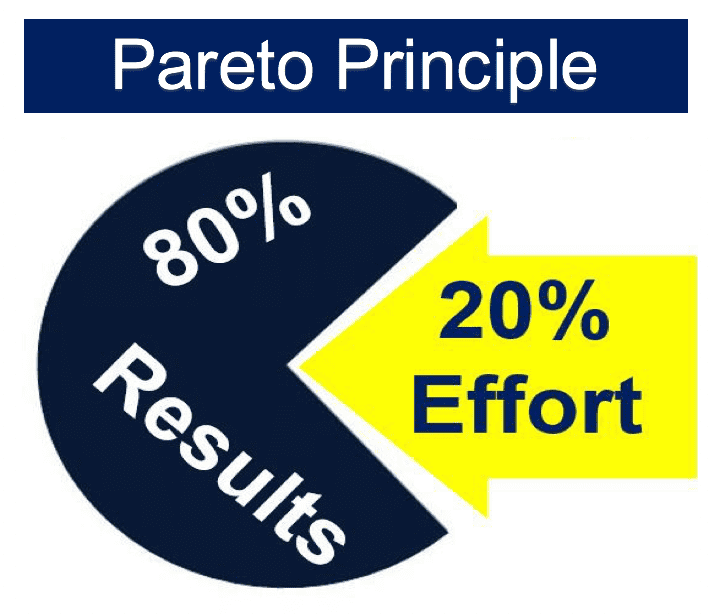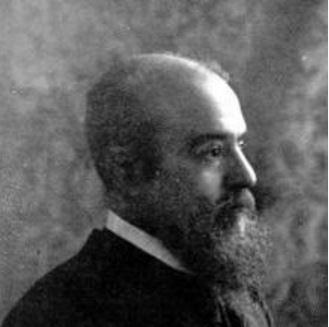The Pareto Principle, or 80/20 Rule, is a theory that people commonly use in business. It maintains that 20% of the items in a company or system account for 80% of the effect. For example, of a company’s 100 products, twenty are likely to represent 80% of profits.
The Pareto Principle does not only apply to good things. It can also apply to undesirable situations or events. For example, in business, about 80% of all customer complaints relate to 20% of the products. Twenty percent of all computer bugs in existence at any one time are responsible for 80% of crashes.
The Principle does not stipulate that every single situation has an exact ratio of 80/20. It just puts forward that figure as a typical distribution. Put simply; its message says that a small percentage of inputs cause the majority of outputs.

We name the Pareto Principle after Italian economist, engineer, sociologist and political scientist Vilfredo Pareto (1848-1923).In 1906, he pointed out that 20% of Italy’s population owned eighty percent of all property.
Pareto then suggested that this 80/20 ratio may be a natural law. He suggest this because he had found several places in the physical world with similar distributions.
Dr. Joseph Duran (1904-2008), a Romanian-American electrical engineer and management consultant, advanced Pareto’s theory in the 1940s. He coined the term ‘The Pareto Principle’ for the 80/20 ratio. People today often refer to Duran as the ‘father of quality control.’
More generally, it is the observation that the majority of things in nature do not exist in an even distribution. The Pareto Principle can mean:
- 20% of the employees account for 80% of total production.
- 20% of the input accounts for 80% of the result.
- One-fifth of all customers represent 80% of total sales.
- 20% of the features account for 80% of the usage.
- 20% of all computer bugs are responsible for 80% of crashes.
- Twenty percent of the products account for 80% of all customer complaints.
- I use 20% of the clothes in my wardrobe 80% of the time.
The 80/20 figures are simply illustrative. They illustrate the lack of symmetry that frequently appears between work put in and results we obtain.
For example, 15% of work may account for 85% of returns. Alternatively, we could resolve seventy-five percent of problems by focusing on 25% of the causes. The sum of the two figures does not necessarily have to add up to 100 every time.
According to the Cambridge Dictionary, the Pareto Principle is:
“The idea that a small quantity of work or resources (= time, money, employees, etc.) can produce a large number of results.”
The Pareto Principle shows life isn’t fair
In an ideal world, each worker would contribute towards the end product equally. Also, wealth distribution among the population would be fairer than it is today.
However, this is hardly ever the case. In reality, each unit of time or work does not contribute the same amount.
The 80/20 rule suggests that the majority of things have an unequal distribution. Out of every five items, one will be ‘great.’ That great thing, person, feature, or idea will account for the majority of the impact.
We would like life to be fair, where each item contributes and receives equal amounts. Unfortunately, it rarely happens that way. Things hardly ever have a 1/1 ratio.
 Vilfredo Pareto (1848-1923) once said: “For many events, roughly 80% of the effects come from 20% of the causes.” (Image: Wikipedia)
Vilfredo Pareto (1848-1923) once said: “For many events, roughly 80% of the effects come from 20% of the causes.” (Image: Wikipedia)
Pareto Principle Analysis in our personal lives
Many personal aspects of our lives also follow the 80/20 principle. If you have an account, look at the ‘likes’ on your Facebook posts. You will most likely find that approximately 80% of your likes come from about twenty percent of your friends.
Even mobile phone messages follow the Pareto Principle. Twenty percent of contacts in most people’s smartphones represent about 80% of all messages, according to pinnacle.com.
Applying the Pareto Principle in time management can lead to increased productivity, as it suggests focusing on the 20% of tasks that yield 80% of the results.
Why is the Pareto Principle useful
The Pareto Principle helps us realize that most outcomes are the result of a minority of inputs. Therefore, if…
– Twenty percent of workers account for four-fifths of the results, we should focus on rewarding them. Alternatively, we could send the other 80% on tailor-made training courses.
– 20% of customers make up 80% of our income, we should channel more resources towards satisfying those customers. We call these consumers heavy users.
In marketing, the Pareto Principle often guides resource allocation, highlighting the importance of focusing on the 20% of customers or channels that generate 80% of sales or engagement.
– 20% of bugs are responsible for 80% of crashes, our priority should be fixing those bugs first.
We should first determine where that 20% is, and then focus on them. We would subsequently get a better return on invested time and resources.
Video -What is the Pareto Principle?
This interesting video, from our sister channel in YouTube – Marketing Business Network, explains what the ‘Pareto Principle’ is using simple and easy-to-understand language and examples.
